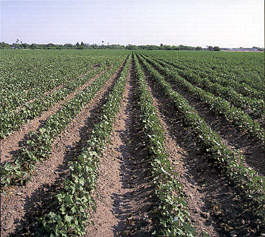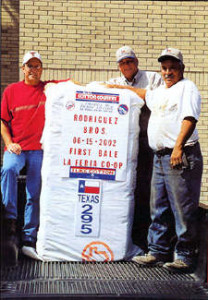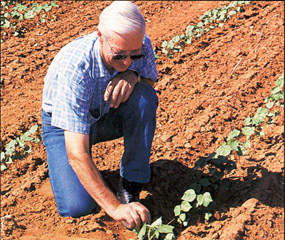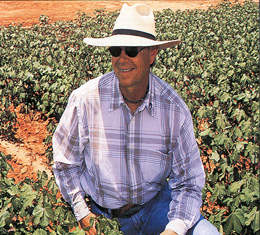From the southern tip of Texas to the southern plains of Kansas, cotton producers and market observers are monitoring the progress of the 2002 crop. Overall, cotton conditions can be described best as a “mixed bag” with farmers in some areas expecting bumper crops and others hoping the insurance adjuster will be kind. The cotton harvest already has begun in South Texas, but cotton growers in the remainder of the state, as well as Oklahoma and Kansas, have several weeks of nervous anticipation ahead of them.
South Texas
By John Johnson
Good, bad and ugly were words used recently to describe the 2002 Lower Rio Grande Valley (LRGV) cotton crop as continued drought and restricted irrigation throughout the season created an uncertain production outlook.
Typical January and February precipitation never materialized, leaving dryland acreage vulnerable ahead of planting. As a result, some fields were dry-planted but never achieved a stand and have been “zeroed out” by insurance adjusters. Cold temperatures also forced some replanting by LRGV farmers.

Dryland cotton in the LRGV has suffered from drought.
“We have some good cotton where irrigation water was available,” said La Feria Coop Gin Manager Ed Landry. “We also have some mediocre cotton that is harvestable.” In late June, Landry was preparing his gin for a normal crop, although potential yields at the time were unknown. La Feria Coop member and PCCA Director Steve Bauer noted June weather was atypical this year.
“Normally, we get some rain here in June that helps finish the crop,” Bauer said, “but high temperatures and persistent winds dominated our weather. It seemed more like July than June.” A few miles further west, Progreso Coop Gin Manager Mike Yeary was facing another short crop.
“Our members haven’t had as much water as they need for two years,” Yeary explained. “Consequently, they put what water they do have on crops that will make the most money such as sugarcane,” he added.
“I hope we’ll gin 7,000 bales this year,” Yeary continued. “That’s about 60 percent of what we consider an average season here.” Despite periodic dry conditions, some gin managers in the Coastal Bend of Texas were expecting the 2002 crop to exceed last year’s.
“We haven’t had the best growing conditions throughout the area this year, but somehow I truly believe we’ll gin more cotton than a year ago,” said Gulf Coast Coop Manager Jim Massey.

L-R: La Feria Coop Manager Ed Landry, cotton seed producer Tom Kilgore and Lorenzo Rodriguez of Rodriguez Bros. Farms at Santa Rosa, Texas, proudly display the nation’s first bale from the 2002 crop. The bale was ginned at La Feria Coop on June 15 after more than 20 members of the Rodriguez family hand-picked the cotton.
Widespread rainfall in early July was not expected to have much impact, good or bad, on the 2002 crop other than delayed defoliation in the LRGV and near Corpus Christi. Any impact on quality will not be known until harvest is well underway.
Growers in the Upper Coastal Bend may face a different set of problems following July’s rainfall. Since the crop there normally is planted after the crops in the Corpus Christi and LRGV areas, the recent precipitation could cause a late-season outbreak of damaging insects and force producers to increase expenses for effective control.
Although the planting season began with adequate subsoil moisture, a steady trickle of timely rains in Central Texas has enhanced an excellent cotton crop potential, and many producers there expect above average yields.
Cotton production in the area might be marginally lower than last year, however, as cotton acreage in Williamson County and the immediate Taylor, Texas, area fell significantly this year. The lower number of cotton acres are due in part to the implementation of a boll weevil eradication program, according to Cris Gwinn, PCCA’s field service representative in Central Texas.
“The confusion and fear of the unknown that often surrounds the first year of an eradication program compelled many producers to plant crops other than cotton this year,” Gwinn said. “The cost of the program combined with the low price of cotton forced area farmers to the sidelines this year, but I expect cotton acreage to go back up again next year,” he added.
Rolling Plains
By Valerie Flattmann
A dry spring followed by untimely rain and cool tempera-tures has affected portions of the 2002 Rolling Plains cotton crop.
“The cool weather and rain put us a little behind,” Tommy Chapman, manager at O’Brien Coop Gin said. “The rain was our primary setback in getting our May and June crop going. The coolness that came along with the rain didn’t allow our crops to load up like they should and left us two weeks behind our pace from last year.”
Chapman said a year ago at this time the cotton crop was in good shape, but production may be lower this season as the additional moisture has created a bollworm infestation that has damaged many fields in the area.

Colorado City Producers Coop Manager Elroy Bodecker
At Colorado City Producers Coop Gin, “wonderful” describes the condition of members’ crops, according to Manager Elroy Boedeker. He said the crop is different from last year because of additional moisture and late planting while acreage remained constant.
“All of the moisture was good for us,” Boedeker said, “but if we don’t get any more rain in the next 30 days, we may not have the same luck with our crop as we’ve been having recently.”
Boedeker expects higher ginning this year and is happy the drought did not extend into this cropping season as it did last year. Bodecker says all the cotton in his area is up, growing and looking good.
Jerry Multer at Wall Coop Gin had to deal with an absence of rain and soil moisture in his area. Less cotton was planted than last year mainly because of low cotton prices, he said. Withstanding nearly five years of drought, the lack of cotton yields also has forced farmers to turn to other crops that can endure the heat, too.
“Between March 18 and March 23, we had less than an inch of rain which resulted in a smaller cotton crop with a lower yield potential and return,” Multer said. “Last year we exceeded our average ginning, so we’re lucky because the drought really has put a hold on production.”
Multer said he is optimistic about the coming year, but added his coop is depending on a wet fall season to boost yields.
High Plains
By Jamie Woolley
Crop conditions and predictions on the Texas High Plains are mostly favorable for the upcoming harvest. However, conditions do vary across the area in all aspects from precipitation to the amount of cotton planted compared to last year.
In July, Marvin McCaul, manager of Maple Cooperative Gin in Bailey County, said crops there received about two inches of rain in late March or early April but have seen only trace amounts since then except for about two inches in early July.
McCaul said more cotton was planted this year than in 2001, but he expects a decrease in the volume ginned this fall.

Terry County Coop Manager Kyle King
“We anticipate a decrease in ginning as compared to last year because all of our dryland crop is gone,” McCaul said.
Terry County Coop Gin Manager Kyle King foresees ginning will be about the same as last year. He said the county started out with more cotton planted, but because some was lost to hail and high winds, the coop will end up ginning about the same number of bales as a year ago.
“The rain was wonderful when it came,” King said, “but it was just a little too late for most of our dryland crop. The irrigated crops look good except west of Brownfield where it was damaged by hail.” Meanwhile, crops in the Union Coop Gin community in Lubbock County look very promising for the upcoming harvest.
“Our crops are looking really good,” said Union Coop Gin Manager Buzz Cooper in July. “We don’t mean to brag; we’re just very thankful right now. As soon as we say too much, something will go wrong. We’re just tickled right now, though.”
He said the Union area has received spotted rain ranging from well under an inch to more than an inch and that some of the showers have been enough to be very beneficial.

United Farm Industries Manager George Reed
According to George Reed, manager of United Farm Industries in Plainview, this year’s crop looks promising for Hale County as well. He said farmers there planted and anticipate harvesting about the same amount of cotton as the previous year. In July, he said the area had not had any substantial rains other than a few showers early in the month when much of the state received several inches. Despite the lack substantial rainfall, he said the upcoming crop looks good.
“Our crops are looking really good this year,” Reed said, “especially around Plainview where the crops look excellent.” Steve Newton, manager of Owens Coop Gin in Crosby County, said his members’ crops also look promising this year.
“We have less cotton planted than in 2001, but we’ll actually gin more because so much was lost to hail damage last year,” Newton said in July.
He also said there is no pressure from insects, and he has seen no boll weevils to speak of.
“Our crops received some beneficial rain in early July, but we need more rain to finish out the crop,” Newton added.
Oklahoma/Kansas
By Lynette Cockerell
Most Oklahoma and Kansas cot-ton producers remain un-daunted by an array of circumstances set in motion by Mother Nature. Despite the lack of moisture, irrigation concerns, and the appearance of insects in some areas, cooperative gins in both states are optimistic and anticipate a successful season.
Ok-Kan Cotton Coop, now in its fourth year of business, expects to have a crop comparable to last season’s, according to Gin Manager Gary Feist. The lower-than-average rainfall in the Anthony, Kan., area has taken a toll on the acres planted to cotton, a fairly new crop for Kansas producers, in a region that still is predominately dryland.
“We’ve lost some of our dryland acres due to lack of moisture the last few years, but production of irrigated cotton is on the rise,” Feist said. “I still expect to gin close to what we did last year.” As a whole, Feist said the cotton in his area is in good shape.
“With some rain at the right time, our dryland could really come on and make a great crop,” he added.
The crop situation at Southern Kansas Cotton Growers (SKCG) in Winfield, Kan., is harder to pinpoint due to the coop’s extensive service area. Gene Latham, SKCG manager and in-house entomologist, said the gin hauls cotton from fields approximately 170 miles to the northeast and up to 80 miles south of the gin.

Southern Kansas Cotton Growers Manager Gene Latham, Winfield, Kan.
“We have good, bad, ugly and everything in between,” joked Latham. “Really, we have a small percentage of cotton in excellent condition and a modest amount that could be considered poor, but most of our cotton is somewhere in the middle,” he said.
Producers at SKCG now have five years of cotton experience, but the relative newness of cotton as an alternative crop in Kansas leaves farmers without a “normal” year with which to compare their progress.
“Every year brings with it a new challenge and usually several things I’ve never seen before,” said Latham. “This year, we
had grasshoppers destroy a few fields of emerging cotton. Also, we have a few bollworms in pre-bloom cotton; that’s a strange occurrence.”
Despite a few insect and moisture concerns in some areas, the outlook for SKCG’s upcoming ginning season is encouraging. “A really good crop could be just an August rain away,” Latham said with optimism.
Ray Hightower, Tri-County Cooperative Gin Manager in Dodson, Texas, radiated with enthusiasm when he recently discussed the crop conditions in his area and noted the coop almost doubled its acres this season. In addition, producers were fortunate enough to receive 6.5 inches of rain between June 15 and July 15. According to Hightower, an abundance of summer rain is a phenomenon rarely seen in his area.
“I haven’t seen a crop this good in I don’t know how long,” Hightower said. “All this rain means a great crop on the way, happy farmers and job security for me, and I like it,” he added with a smile.
Thrips and aphids have made a noticeable appearance in the area. Although some producers have begun to spray pesticides, the problem is causing only minimal concern.
“Sure, we’ve got some insects, but they certainly are not out of control. We really don’t have a lot to complain about at the moment, and it’s looking good for us,” Hightower concluded.

Tri-County Coop Manager Ray Hightower
Cotton producers who deliver their cotton to Tillman Producers Coop Gin in Frederick, Okla., also are optimistic about their crop, said Manager David Lingle. Up to four inches of rain has fallen in the area since July 1 providing adequate moisture for the developing crop. However, the abundance of moisture has created a small worm problem which producers in the area are not accustomed to dealing with in an average year.
“We may do as well or better than last year as far as production numbers,” Lingle said. “I expect to gin cotton from approximately the same amount of acres as last year, and I think the Bt cotton can handle our small worm problem.”
Insects were not a concern in July for Altus Cotton Growers Manager Mike Berry, but water soon might be. As of this writing, cotton in the Altus area was in good shape due to adequate rainfall. However, Berry said the water level at Lake Altus, where most of the region’s irrigation water is pumped, is lower than optimal. Without additional rainfall to fill the lake, producers may be forced to irrigate every other row.
Berry summarized the feelings of most gin managers in Texas, Oklahoma and Kansas when he said, “All we need is a little help from Mother Nature. Like most everybody in the cotton business, the perfect amount of rain at the perfect time could result in a bumper crop for us.”


